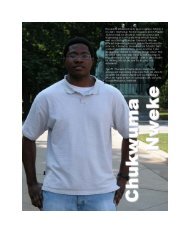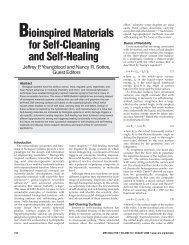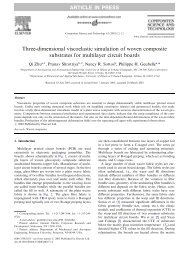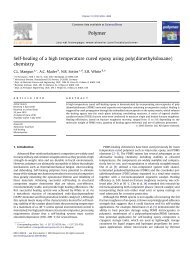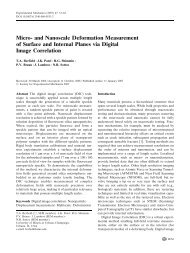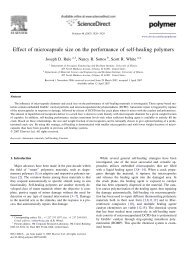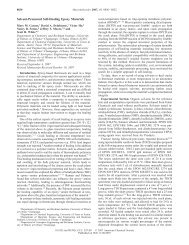Self-healing Polymers and Composites - Sottos Research Group
Self-healing Polymers and Composites - Sottos Research Group
Self-healing Polymers and Composites - Sottos Research Group
Create successful ePaper yourself
Turn your PDF publications into a flip-book with our unique Google optimized e-Paper software.
<strong>Self</strong>-<strong>healing</strong> <strong>Polymers</strong> <strong>and</strong> <strong>Composites</strong>Capsules, circulatory systems <strong>and</strong> chemistry allow materials to fix themselvesScott R. White, Benjamin J. Blaiszik, Sharlotte L. B. Kramer, Solar C. Olugebefola,Jeffrey S. Moore <strong>and</strong> Nancy R. <strong>Sottos</strong>Nothing lasts forever. Any humanmadematerial, used in anythingfrom toys to bridges, will eventuallyfail, if not maintained <strong>and</strong> repaired.Traditionally, this problem has been addressedthrough extensive inspection<strong>and</strong> expensive replacement of damagedparts. Biological systems, however, haveevolved to include alternative ways torepair internal <strong>and</strong> external damage via<strong>healing</strong> mechanisms. Materials researchersworldwide, including those in ourgroup, have been working on methods tomimic these <strong>healing</strong> abilities in polymers,composites <strong>and</strong> other synthetic materials.Such self-<strong>healing</strong> materials, when triggeredby a crack or tear, can repair themselves<strong>and</strong> recover their original functionalityusing only the materials that areinherently available to them. They offer anew means to achieve safer <strong>and</strong> longerlastingproducts <strong>and</strong> components, <strong>and</strong>signal a shift in the traditional paradigmsof material design <strong>and</strong> engineering.The guiding principles for syntheticself-<strong>healing</strong> are seen in biological systems.Damage that causes injury triggersthe first response, inflammation<strong>and</strong> blood clotting. This initiating stepis followed by cell proliferation at thesite of injury, which deposits a matrixfor the repair. The final stage of <strong>healing</strong>,matrix remodeling, is the regrowthof new tissue to fill in the wound. Thisprocess can take place over a longerScott R. White is a professor of aerospace engineeringat the University of Illinois. Benjamin J. Blaiszik is apostdoctoral fellow at the Center for Nanoscale Materialsat Argonne National Laboratory. Sharlotte L.B. Kramer <strong>and</strong> Solar C. Olugebefola are postdoctoralresearchers, Jeffrey S. Moore is a professor of chemistry<strong>and</strong> Nancy R. <strong>Sottos</strong> is a professor of materialsscience at the University of Illinois. This article wasadapted from Blaiszik, B. J., et al. 2010. <strong>Self</strong>-<strong>healing</strong><strong>Polymers</strong> <strong>and</strong> <strong>Composites</strong>. Annual Review ofMaterials <strong>Research</strong> 40:179–211. Address for White:Department of Aerospace Engineering, Universityof Illinois, Urbana-Champaign, Urbana, IL 61801.E-mail: swhite@illinois.eduperiod, months to possibly years, dependingon the severity of the injury.In synthetic systems, there is a similarcascade of events, but it is more simplistic<strong>and</strong> takes place at a faster rate. At first,damage actuates the start of the process,then new materials are transported tothe site rapidly, <strong>and</strong> <strong>healing</strong> occurs asthe material reacts to form an adhesivebond with the damaged area. Most oftenthe <strong>healing</strong> agent is made of two typesof liquid materials that solidify whenmixed. Finally comes a chemical repairprocess, analogous to matrix remodeling;its timescale varies depending onthe type of <strong>healing</strong> mechanism, but itoccurs in the range of hours to severaldays at most. The goal of self-<strong>healing</strong> isto match the rate of repair with that ofthe damage, thereby achieving a state ofstasis in the material. The rate of damageis largely controlled by external factors,such as the material’s strain rate, howfrequently it experiences loading <strong>and</strong> themagnitude of the loading. However, the<strong>healing</strong> rate can be adjusted by, for example,varying temperature or chemicalreactionrates through control of rawmaterialtypes <strong>and</strong> concentrations.<strong>Research</strong> on self-<strong>healing</strong> materials isrelatively new, with most of the progresscoming within the last decade. Althoughin theory any material can self-heal, theresults for polymers <strong>and</strong> fiber-reinforcedcomposites are relatively more maturein comparison with efforts in ceramics,metals <strong>and</strong> other materials. Whateverthe class of material, self-<strong>healing</strong> mechanismscan be broadly classified into threegroups: capsule-based, vascular <strong>and</strong> intrinsic.Each group differs by the methodused to sequester the material’s <strong>healing</strong>functionality until it is triggered by damage.The groups also vary by the differentamounts of damaged volume thatthey can heal, as well as the repeatabilityof <strong>healing</strong> in the same location <strong>and</strong> therate of <strong>healing</strong>. Thus each approach hasits own challenges <strong>and</strong> advantages.Capsule-based materials incorporatea <strong>healing</strong> agent that is held <strong>and</strong> protectedin discrete spherical shells, which areruptured by damage. The self-<strong>healing</strong>mechanism is activated by the release<strong>and</strong> reaction of the <strong>healing</strong> agent at thedamage site. However, after release,the <strong>healing</strong> agent is depleted, so it onlyworks for a single local <strong>healing</strong>.Vascular materials carry the <strong>healing</strong>agent in a network of capillariesor hollow channels, which may besingle tubes, discrete planes of interconnectedtubes, or three-dimensionalnetworks of channels. When damageruptures the vasculature <strong>and</strong> deliversthe <strong>healing</strong> agent, the network can berefilled (either from an external sourceor from undamaged, connected channels),so it can support multiple local<strong>healing</strong>events.Intrinsic materials instead have a latentself-<strong>healing</strong> ability, usually builtinto the chemical network of the polymermaterial, rather than a separate,sequestered <strong>healing</strong> agent. They rely onrepairs made through molecular-scalemechanisms, such as hydrogen bonding,ionic interactions or polymer-chainmobility <strong>and</strong> entanglement. Each ofthese mechanisms is reversible, makingmultiple <strong>healing</strong>s possible.Raw MaterialsFor capsule-based materials, there are anumber of techniques for creating polymershell walls that protect the reactivematerials inside them. The most commonmethods involve forming a shellat the interface of droplets in an oil-inwateremulsion. In this case, the resultingshell will be thin <strong>and</strong> brittle, likethat of an egg, <strong>and</strong> it will rupture whenforce is applied. Another procedure involvesemulsifying a melted polymerso that it forms droplets, which are thensolidified by a temperature change orby the removal of a solvent, creating athick protective sphere around the core.392 American Scientist, Volume 99 © 2011 Sigma Xi, The Scientific <strong>Research</strong> Society. Reproductionwith permission only. Contact perms@amsci.org.





